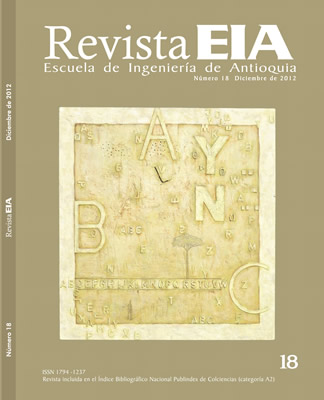RESPIROMETRÍA DE Phragmites australis EN PRESENCIA DE MATERIA ORGÁNICA DISUELTA Y EL XENOBIÓTICO CLOROTALONILO (RESPIROMETRY OF Phragmites australis IN PRESENCE OF DISSOLVED ORGANIC MATTER AND THE XENOBIOTIC CHLOROTHALONIL)
RESPIROMETRÍA DE Phragmites australis EN PRESENCIA DE MATERIA ORGÁNICA DISUELTA Y EL XENOBIÓTICO CLOROTALONILO (RESPIROMETRY OF Phragmites australis IN PRESENCE OF DISSOLVED ORGANIC MATTER AND THE XENOBIOTIC CHLOROTHALONIL)


This work is licensed under a Creative Commons Attribution-NonCommercial-NoDerivatives 4.0 International License.
Copyright statement
The authors exclusively assign to the Universidad EIA, with the power to assign to third parties, all the exploitation rights that derive from the works that are accepted for publication in the Revista EIA, as well as in any product derived from it and, in in particular, those of reproduction, distribution, public communication (including interactive making available) and transformation (including adaptation, modification and, where appropriate, translation), for all types of exploitation (by way of example and not limitation : in paper, electronic, online, computer or audiovisual format, as well as in any other format, even for promotional or advertising purposes and / or for the production of derivative products), for a worldwide territorial scope and for the entire duration of the rights provided for in the current published text of the Intellectual Property Law. This assignment will be made by the authors without the right to any type of remuneration or compensation.
Consequently, the author may not publish or disseminate the works that are selected for publication in the Revista EIA, neither totally nor partially, nor authorize their publication to third parties, without the prior express authorization, requested and granted in writing, from the Univeridad EIA.
Show authors biography
La frecuencia respiratoria de Phragmites australis en presencia de agua residual sintética (ARS) y clorotalonilo(CLT) se evaluó utilizando un respirómetro. El estudio se dividió en dos fases, con los siguientes tratamientos: fase Icon a) agua de grifo, b) agua de grifo + P. australis, c) ARS; fase II con a) ARS + CLT (0,29 mg L-1), b) ARS + CLT(2,18 mg L-1), c) CLT (0,29 mg L-1), d) CLT (2,18 mg L-1). Cada experimento se realizó por duplicado. Se analizó lainfluencia de las variables humedad relativa (HR), radiación solar (Rs), temperatura ambiente (T), presión barométrica(PB), evaporación y la evapotranspiración potencial (ETo) sobre la frecuencia de respiración de P. australis.No se encontraron diferencias significativas de la frecuencia respiratoria de P. australis (p < 0,05) con aguade grifo y ARS durante los experimentos de la fase I; lo mismo se encontró para todos los experimentos de la fase II. Las variables climatológicas afectaron la frecuencia respiratoria en todos los tratamientos. ETo, T y R mostraronuna correlación positiva significativa con la frecuencia respiratoria; y la HR y la PB, una correlación negativa.
Abstract: The respiratory rate of Phragmites australis exposed to synthetic sewage water (SSW) and chlorothalonil (CLT)was evaluated using a respirometer. The study was divided into two phases with the following treatments: phase Iwith a) tap water, b) tap water + P. australis, c) ARS; phase II with a) SWW+ CLT (0,29 mg L-1), b) SWW + CLT(2,18 mg L-1), c) CLT (0,29 mg L-1), d) CLT (2,18 mg L-1). Each experiment was done by replicate. The influence ofrelative humidity (RH), solar radiation (SR), air temperature (T), barometric pressure (BP), evaporation and potentialevapotranspiration (ETo) on P. australis respiration rate was analyzed. No significant differences were found on therespiratory rate of P. australis (p < 0.05) using tap water and SWW during phase I experiments; the same findingwas seen for all phase II experiments. Meteorological variables affected the respiratory rate in all treatments. ETo,T and SR showed significant positive correlation with respiratory rate; RH and BP, a negative correlation.
Article visits 335 | PDF visits 186
